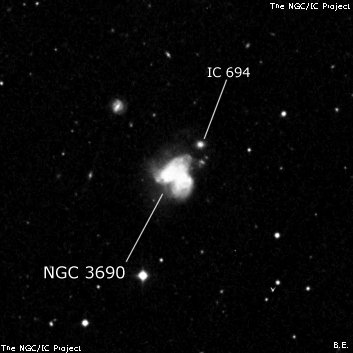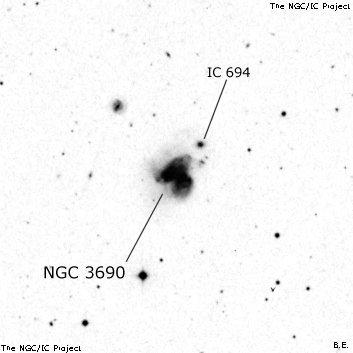NGC/IC Project Restoration Effort
(This is a very very beta version)
NGC3690


Basic Information
Location and Magnitude
Right Ascension: 11:28:32.6
Declination: +58:33:52
Constellation: UMA
Visual Magnitude: 10.9
Historic Information
Discoverer: Herschel W.
Year of discovery: 1790
Discovery aperture: 18.7
Observational
Summary description: pB, pS, vlE 80° ±, pgbM, S st sf nr
Sub-type: Sb/P
Corwin's Notes
=====
NGC 3690 and IC 694 (which see for more discussion). These are not, as is
often supposed, the two components of the peculiar interacting system, Arp
299. Instead, NGC 3690 refers to these two peculiar galaxies, while IC 694
is the small elliptical or lenticular about an arcmin northwest. Lord Rosse
clearly resolved the two components in at least one of his observations, and
he also noted IC 694 as an "appendage" to the north-west of the pair. Swift
later rediscovered the IC object; this led Dreyer to assign it its own number
in the first IC.
Note, too, that the numbers NGC 3690 and IC 694 are incorrectly assigned to
Arp 296 in the tables in the Arp Atlas. This has further exacerbated the
naming problem, as Arp 296 is another interacting pair just a few arcmin
following Arp 299.
Steve's Notes
=====
NGC 3690
48" (5/12/12): at 488x, the southwest component (VV 118b) of NGC 3690 appeared as a very bright, elongated, irregular knot of high surface brightness. Contains a very bright, quasi-stellar nucleus. The northeast component (VV 118a) is the larger of the merged interacting pair and appeared bright, moderately large, ~1' diameter, small very bright core. A very low surface, asymmetric halo extends on the northwest side of the bright pair. The southwest component is generally misidentified as IC 694, which is described below.
VV 118d/e, probably HII regions, are just 45" NW of NGC 3690 (just outside the halo). Occasionally an extremely faint and small glow popped in this position, 6"-8" diameter. IC 694, ~1' NW of the bright pair, was easily visible as a fairly faint, slightly elongated glow, 15"x12", weak concentration. PGC 35345 (the brighter component of Arp 296) lies 2.6' NE. It was also a direct vision, fairly faint glow, fairly small, oval 4:3 NW-SE, 24"x18", increasing to a very small brighter core.
17.5" (4/1/95): NGC 3690 is a disrupted, interacting double system (Arp 299). This unusual pair appears moderately bright, fairly small, elongated E-W. The appearance is confusing with two very small "knots" in a common halo elongated E-W (20" between centers). On the west side is a fairly bright virtually stellar "knot", which is probably the nucleus of the brighter member of NGC 3690. There is a small fainter unconcentrated extension on the following end and the two components are not individually resolved. With averted vision, IC 694 was barely glimpsed as an extremely faint spot about 1' NW.
17.5" (3/19/88): fairly bright, moderately large, elongated ~E-W, irregular, mottled appearance. A mag 14 star is superimposed on the west side and an extremely faint mag 15.5 star or knot is involved. This is a disrupted interacting system which includes IC 694.



